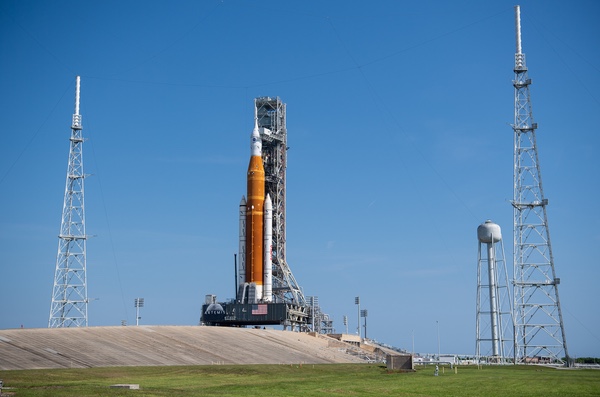Since I was a young child Mars held a special fascination for me. It was so close and yet so faraway. I have never doubted that it once had advanced life and still has remnants of that life now. I am a dedicated member of the Mars Society,Norcal Mars Society National Space Society, Planetary Society, And the SETI Institute. I am a supporter of Explore Mars, Inc. I'm a great admirer of Elon Musk and SpaceX. I have a strong feeling that Space X will send a human to Mars first.
Tuesday, August 30, 2022
Monday, August 29, 2022
When Space Screams!
When Space Screams
The slogan of the original “Alien” movie read, “In space, no one can hear you scream.”
While sound cannot conventionally travel in space – unlike on Earth – there is a scary cacophony coming from a supermassive black hole located about 250 million light-years away from Earth, Newsweek reported.
NASA researchers recently released a 34-second video clip on Twitter containing an eerie sound emanating from the Perseus cluster of galaxies. The clip was originally posted in May but it gained more attention when it was reposted last week on the agency’s Twitter account for its exoplanet programs.
Many netizens were in awe of the peculiar sound but others pointed out that the celestial body sounded like “a billion souls being tortured,” according to Insider.
The agency explained that the black hole was first discovered in 2003 and has ever since been associated with sound.
“This is because astronomers discovered that pressure waves sent out by the black hole caused ripples in the cluster’s hot gas that could be translated into a note,” it wrote in the original May post.
NASA originally picked up data from the ripples using its Chandra X-ray Observatory but the actual sounds cannot be heard by the human ear.
To make them audible, they had to amplify the sounds 144 and 288 quadrillion times above their original frequency to get them from their true pitch to something that can be heard.
The results, however, were something akin to “cosmic horror,” as another Twitter user quipped.
Sunday, August 28, 2022
Friday, August 26, 2022
Wednesday, August 24, 2022
Our Beloved Griffith Observatory
It’s Wednesday. Roughly seven million people have looked through the main telescope at Griffith Observatory. Plus, Gov. Gavin Newsom vetoed a bill for supervised drug-injection sites. |
|
LOS ANGELES — Atop a hill that offers views of glittering freeways and golden mountains is one of this city’s most popular attractions, drawing tourists who spend hours waiting in line to gaze upon it. |
The must-see isn’t a collection of Hollywood memorabilia or a dazzling museum installation, but a telescope that has been operating in the Los Angeles hills for almost nine decades. |
The 12-inch Zeiss refracting telescope is arguably the showpiece of Griffith Observatory, housed in the easternmost dome that forms the building’s crown-like outline. And like any proper Los Angeles icon, the telescope has its own claim to fame. |
“More people have looked through that telescope than any other telescope else in the world,” E.C. Krupp, director of Griffith Observatory, told me. |
To be clear, this is only a claim. There’s no “telescope sheriff” or other authority to officially bestow this title on the Zeiss, Krupp explains. But his evidence is difficult to dispute. |
|
On a recent Los Angeles summer evening, tour buses unloaded crowds of visitors onto the lawn in front of a gleaming observatory. Couples took selfies with the Hollywood sign in the background, friends shared picnics and locals laid on the grass beside their dogs and bicycles. |
Around 6:45 p.m., I climbed the stairs to the observatory’s roof to see the Zeiss. There was more than an hour till sundown and telescope viewing hadn’t begun yet, but already two dozen people were lined up. |
Here we encounter the first piece of Krupp’s evidence: Griffith Observatory is extremely popular. It’s a major landmark in a metropolis that attracts millions of tourists from around the world each year. |
|
The Zeiss isn’t a modern marvel like the new James Webb Space Telescope, but rather a 9,000-pound, German-made behemoth that’s been here since 1935, when Griffith first opened its doors. The observatory’s benefactor, Griffith J. Griffith, believed that the public, not just scientists, should be able to look at the stars. |
“The real charm of the telescope is that people actually get to look through it, and that’s the fundamental principle of this place,” Krupp said. “We really intend to put people’s eyeballs to the universe.” |
By 7 p.m., dozens more people had lined up behind me, and the growing queue was cordoned off as if we were at an amusement park. Around me were sunglasses, cameras, backpacks and a mélange of languages and accents. |
“Is this the line?” asked a man wearing a Dodgers hat. He shook his head when he found out that it was. |
By Krupp’s count, approximately seven million people have pressed their eye to the Zeiss telescope since it opened. He believes this figure, which comes from tallies kept by observatory staff who man the telescope, is almost definitely greater than that for any other telescope because: |
|
|
Krupp, who has been director of the observatory since 1974, told me that he began advertising the Zeiss as the most looked-through telescope in the world about two decades ago. He would be “surprised and disappointed” if someone proved him wrong, he said. |
“We’ve been claiming that for a very long time, with the idea that if there were challengers wishing to take us down a notch or two, they’d do that,” Krupp said. “And they haven’t.” |
When I made it to the front of the line, I entered through a low doorway into the dome that houses the telescope. The masked faces around me craned their necks to look at the metallic monstrosity. |
I climbed a few steps to reach the telescope’s eyepiece, pointed at a star 25.3 light-years from Earth. A staff member grabbed a microphone to narrate the experience. |
“More people have looked through it than any telescope in the world,” he boomed. “You join that illustrious history tonight.” |
For more: |
|
Tuesday, August 23, 2022
The Growing Strategic Importance Of Private Satellite Companies
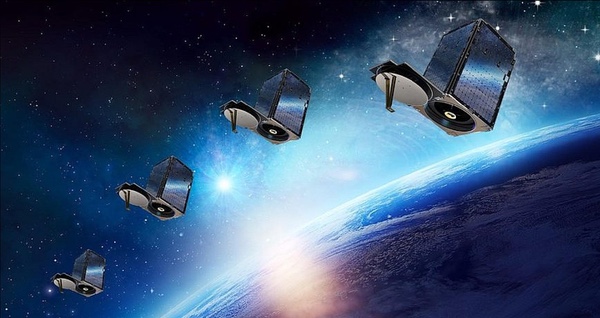 High-resolution imaging satellites, like the Skysat series operated by Planet, have had a major effect on the war in Ukraine. (credit: Maxar) |
War in Ukraine highlights the growing strategic importance of private satellite companies, especially in times of conflict
by Mariel Borowitz
Monday, August 22, 2022
Satellites owned by private companies have played an unexpectedly important role in the war in Ukraine. For example, in early August 2022, images from the private satellite company Planet Labs showed that a recent attack on a Russian military base in Crimea caused more damage than Russia had suggested in public reports. Ukrainian President Volodymyr Zelenskyy highlighted the losses as evidence of Ukraine’s progress in the war.
| Based on the strategic value commercial satellite imagery has held during this war, I believe it is likely that more nations will be investing in private satellite companies. |
Soon after the war began, Ukraine requested data from private satellite companies around the world. By the end of April, Ukraine was getting imagery from US companies mere minutes after the data was collected.
My research focuses on international cooperation in satellite Earth observations, including the role of the private sector. While experts have long known that satellite imagery is useful during a conflict, the war in Ukraine has shown that commercial satellite data can make a decisive difference, informing both military planning as well as the public view of a war. Based on the strategic value commercial satellite imagery has held during this war, I believe it is likely that more nations will be investing in private satellite companies.
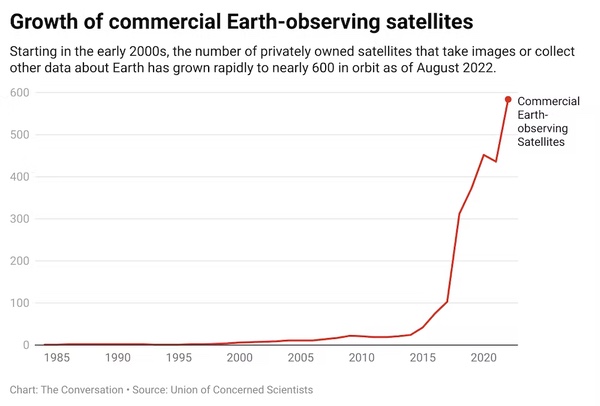 |
Growth of the commercial satellite sector
Remote-sensing satellites circle the Earth collecting imagery, radio signals, and many other types of data. The technology was originally developed by governments for military reconnaissance, weather forecasting, and environmental monitoring. But over the past two decades, commercial activity in this area has grown rapidly, particularly in the US. The number of commercial Earth observation satellites has increased from 11 in 2006 to more than 500 in 2022, about 350 of which belong to US companies.
The earliest commercial satellite remote-sensing companies worked closely with the military from the beginning, but many of the newer entrants were not developed with national security applications in mind. Planet, the US-based company that has played a big role in the Ukrainian conflict, describes its customers as those in “agriculture, government, and commercial mapping,” and it hopes to expand to “insurance, commodities, and finance.” Spire, another US company, was originally focused on monitoring weather and tracking commercial maritime activity. However, when the US government set up pilot programs in 2016 to evaluate the value of data from these companies, many of the companies welcomed this new source of revenue.
Value of commercial data for national security
The US government has its own highly capable network of spy satellites, so partnerships with private companies may come as a surprise, but there are clear reasons the US government benefits from these arrangements.
First is the simple fact that purchasing commercial data allows the government to see more locations on the Earth more frequently. In some cases, data is now available quickly enough to enable real-time decision-making on the battlefield.
The second reason has to do with data sharing practices. Sharing data from spy satellites requires officials to go through a complex declassification process. It also risks revealing information about classified satellite capabilities. Neither of these is a concern with data from private companies. This aspect makes it easier for the military to share satellite informationwithin the US government as well as with US allies. This advantage has proved to be a key factor for the war in Ukraine.
Use of satellite data in Ukraine
Commercial satellite imagery has proved to be critical to this war in two ways. First, it’s a media tool that allows the public to watch as the war progresses in incredible detail, and second, it’s a source of important information that helps the Ukrainian military plan day-to-day operations.
| Before the war, Ukrainian officials thought money was better spent on “down-to-earth” security needs, rather than expensive satellites. But now these officials view satellite imagery as critical. |
Even before the war began in February 2022, the US government was actively encouraging commercial satellite companies to share their imagery and raise awareness of Russian activity. Commercial companies released images showing Russian troops amassing near the Ukrainian border, directly contradicting statements by Russia.
In early March 2022, Ukraine’s Vice Prime Minister, Mykhailo Fedorov, asked eight commercial satellite companies for access to their data. In his request, he said that this could be the first major war in which commercial satellite imagery played a significant role. Some companies obliged, and within the first two weeks of the conflict the Ukrainian government received data covering more than 40 million square kilometers of the war zone.
The US government significantly increased its purchases of imagery that could be provided to Ukraine. The US government has also actively fostered connections directly between US companies and Ukrainian intelligence analysts, helping promote the flow of information.
A recent example of the value of these images comes again from Planet. Over the past few weeks, the company has been releasing images showing the conflict drawing dangerously near the Zaporizhzhia nuclear power plant. In recent days, UN officials have said the situation poses a “very real risk of a nuclear disaster” and pushed for UN experts to be allowed to visit the site.
Before the war, Ukrainian officials thought money was better spent on “down-to-earth” security needs, rather than expensive satellites. But now these officials view satellite imagery as critical both to battlefield awareness and for documenting atrocities allegedly carried out by Russian troops.
Looking forward
Some space experts have called the war in Ukraine the first “commercial space war.” The conflict has clearly shown the national security value of commercial satellite imagery, the ability of commercial satellite images to promote transparency, and the importance of not only national space power, but also the space capabilities of allies.
| The war in Ukraine may well prove to be a key turning point for both global transparency in conflict and the commercial Earth-observing sector as a whole. |
I believe the fact that the US commercial sector had such a significant effect on military operations and public opinion will lead to increased government investment in the private satellite sector globally. Leaders in Ukraine intend to invest in domestic satellite imaging capabilities, and the US has expanded its commercial purchases. This expansion may raise new challenges if abundant satellite imagery is available to actors on both sides of a conflict in the future.
Some Earth-observing satellite companies have expressed hope that the lessons learned will extend beyond war and national security. The ability to rapidly produce images and analysis could be used to monitor agricultural trends or provide insight into illegal mining operations.
The war in Ukraine may well prove to be a key turning point for both global transparency in conflict and the commercial Earth-observing sector as a whole.
This article is republished from The Conversation under a Creative Commons license. Read the original article.
Mariel Borowitz is an Associate Professor in the Sam Nunn School of International Affairs at the Georgia Institute of Technology and director of the Nunn School Program on International Affairs, Science, and Technology. Her research deals with international space policy issues, focusing particularly on global developments related to remote sensing satellites and challenges to space security and sustainability.
Lindy Elkins-Tanton Aportrait of the Scientist As A Young Woman
 |
Review: A Portrait of the Scientist as a Young Woman
by Jeff Foust
Monday, August 22, 2022
A Portrait of the Scientist as a Young Woman: A Memoir
by Lindy Elkins-Tanton
William Morrow, 2022
hardcover, 272 pp., illus.
ISBN 978-0-06-308690-6
US$29.99
Had everything gone according to plan, Lindy Elkins-Tanton would be celebrating a launch this month. Elkins-Tanton is principal investigator for NASA’s Psyche spacecraft, a Discovery-class mission to the metallic main-belt asteroid of the same name. By early May, the spacecraft was at Cape Canaveral for final preparations for a launch on a Falcon Heavy scheduled for early August that would have the spacecraft arrive at Psyche in 2026.
| “There aren’t many people who have led deep space missions and each of us followed our own path,” she writes. “But if there are a series of paths that have worked in the past, I can say with some certainty that I did not follow any of them.” |
However, there were no celebrations and no launch, and Psyche the spacecraft remains in Florida. NASA announced in May that it was postponing the launch to a backup launch window in the fall, then in June postponed the launch indefinitely. Issues with a testbed—a mix of hardware and software from JPL and satellite manufacturer Maxar—delayed testing of key spacecraft software to the point where NASA concluded it would not be ready in time for a launch this year. An independent panel is reviewing the issue as NASA looks for new launch opportunities as soon as the middle of 2023.
Few people, though, may be better equipped to deal with a setback like that than Elkins-Tanton. As she describes in her recent memoir, A Portrait of the Scientist as a Young Woman, her life and career has seen much bigger twists and turns than a delay in a spacecraft launch. “There aren’t many people who have led deep space missions and each of us followed our own path,” she writes early in the book. “But if there are a series of paths that have worked in the past, I can say with some certainty that I did not follow any of them.”
Her path started conventionally enough: going to MIT and getting BS and MS degrees in geological sciences. It then diverged quickly: leaving academia to work in consulting, getting married, having a child, and getting divorced. Only later does her career path start to again resemble a more typical one, with a return to grad school for a PhD and then various positions in academia, including her current one at Arizona State University.
She offers an unvarnished look at the personal and professional challenges in her life, from family relationships to securing jobs in academia, a reminder that life is not a tale of monotonic progress. She lingers on some aspects, like the series of field expeditions to Siberia, looking for rocks that would provide clues to a massive volcanic event 250 million years ago linked to a major extinction, a series of trips that posed physical, cultural, and bureaucratic obstacles to overcome.
| She describes elsewhere in the book the desire to get away from the “hero model” in academia and its equivalent in space, what she calls the “aerospace cavalry”: the team that rides to the rescue of struggling projects, pushes aside the original engineers, and “pull heroic wins out from seemingly certain losses.” |
Elkins-Tanton also provides a fascinating glimpse into the work that goes into winning a competition for a NASA mission like Psyche. That work is more than just writing a proposal and waiting for NASA to select it: for major programs, like the Discovery line of planetary science missions, the agency selects a set of finalists who get funding for additional studies, but with it much more work to convince NASA. That includes months of preparation for what’s known as a “site visit,” where NASA officials come for extensive presentations about and questioning of the mission team. She provides perhaps the most detailed behind-the-scenes perspective yet of the planning for the site visit and the visit itself, as well as the call months later that NASA selected Psyche (along with Lucy, another asteroid mission) from the five finalists considered.
She describes elsewhere in the book the desire to get away from the “hero model” in academia and its equivalent in space, what she calls the “aerospace cavalry”: the team that rides to the rescue of struggling projects, pushes aside the original engineers, and “pull heroic wins out from seemingly certain losses.” Doing so, she argues, take a huge toll on both those who ride to the rescue and those who are rescued. “So I decided the goal was never to be the hero and never to have to call in the heroes,” she writes. “The goal was to do it better from the very beginning.” That view has certainly been challenged, at least, by the problems with Psyche.
Psyche’s future is still uncertain: at a NASA town hall meeting last week, agency officials said a “continuation/termination” review for the mission is tentatively scheduled for early November. As the name suggests, that leaves open the possibility NASA could cancel Psyche, although a more likely outcome is the mission will continue with a new launch date and some additional costs, one that will push back Psyche the spacecraft’s arrival at Psyche the asteroid to late this decade. It may be just another twist in the nontraditional, but ultimately fulfilling, path taken by Elkins-Tanton in her career and her life.
Jeff Foust (jeff@thespacereview.com) is the editor and publisher of The Space Review, and a senior staff writer with SpaceNews. He also operates the Spacetoday.net web site. Views and opinions expressed in this article are those of the author alone.
The Time Haqs Finally Come For Artemis!
The time has finally come for Artemis 1by Jeff Foust |
| “We are in the final stretch,” Blackwell-Thompson said of Artemis 1 plans earlier this month. |
That may finally change next week. As soon as 8:33 am EDT on August 29, the first SLS is scheduled to lift off from LC-39B at the Kennedy Space Center with an uncrewed Orion spacecraft on top. That time marks the start of a two-hour window for the launch, with another two-hour opportunity starting at 12:48 pm EDT September 2. A third launch window opens September 5—Labor Day—at 5:12 pm EDT, for 90 minutes.
As the months leading up to those Artemis 1 launch dates turned into weeks, agency officials have been increasingly confident that everything is, at long last, in place for a launch. That confidence came from a series of fueling and countdown tests called wet dress rehearsals: three in April and one in June that, while never getting to the planned stopping point, exercised the launch vehicle and ground systems enough for agency officials to conclude they were ready to finally move on to launch.
That confidence was in evidence last week, when NASA moved up the rollout of the SLS from the Vehicle Assembly Building to LC-39B by more than 24 hours, having completed all the work they needed ahead of schedule and giving crews some additional margin at the pad to prepare SLS and Orion for launch.
“We are in the final stretch,” Charlie Blackwell-Thompson, Artemis 1 launch director at KSC, said at a briefing earlier this month about the mission. As for an August 29 launch, “We are on plan for that at this time.”
There have still been some issues to deal with in the final weeks. One of them is with the rocket’s flight termination system (FTS), which allows range safety to detonate the vehicle if it goes off course. The FTS system is installed in an intertank region of the SLS’s core stage, an area that can only be accessed while the rocket is in the VAB. Completing that work, including installing its batteries, was one of the last things done on the SLS before rollout.
The problem is that the Space Force, which operates the Eastern Range, only certified the FTS for 20 days after its batteries are installed and tested, which takes place 15 days before the first launch attempt. That would have allowed NASA to proceed with launch opportunities on August 29 and September 2, but the clock would have run out before the September 5 launch. NASA managers said in briefings earlier in the month that they were working with the Space Force on extending that 20-day period for the FTS.
On August 12, NASA announced it had received a waiver from the Space Force extending the lifetime of the FTS from 20 to 25 days, enough to enable a September 5 launch if needed.
The FTS, though, could factor into future launch delays, though. If, for some combination of reasons, Artemis 1 does not launch by September 5, the vehicle will have to roll back to the VAB to refresh the FTS, since it cannot be accessed on the pad. Even if there was no other work needed to get SLS and Orion ready for another launch, agency officials said that the process of rolling back to the VAB and returning to the pad would make it difficult to launch in the next available opportunity, which opens September 20 and runs through October 4.
“That would be a real challenge for us, to be honest with you,” said Cliff Lanham, senior vehicle operations manager in NASA’s Exploration Ground Systems program, of launching during that timeframe during a July briefing. “But we would certainly give it our best shot.”
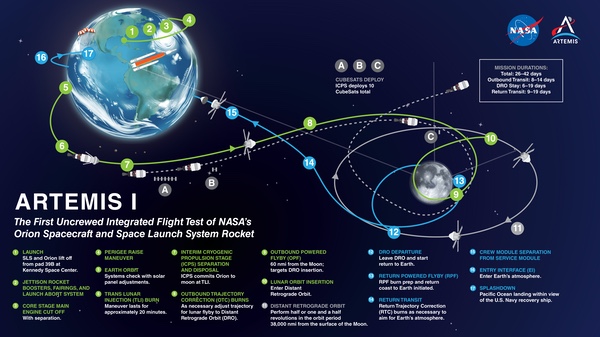 An overview of the Artemis 1 mission (larger version). (credit: NASA) |
Mission overview
For all the attention that the launch itself is getting, far less is going to the overall Artemis 1 mission. That SLS launch only sets the stage for a test flight lasting up to 42 days that will put the Orion spacecraft through its paces and demonstrate that the spacecraft, under development in one form or another for more than 15 years, is finally ready to carry astronauts.
The top objective of Artemis 1 won’t come until the end of the mission, when the spacecraft reenters at speeds of around 40,000 kilometers per hour. That will be the first test of Orion’s heat shield at those velocities.
| If the return powered flyby doesn’t work, LaBrode said, “then it’s a loss of the vehicle.” |
“It’s certainly very important that we accomplish that objective as part of Artemis 1 and really demonstrate what we know from our ground testing to be the capabilities of that heat shield,” said Howard Hu, NASA Orion program manager, at a briefing early this month.
The mission’s second objective is to test all of the capabilities of SLS and Orion during the flight, including life support, propulsion, and communications, among others. “It’s really important that we have a good opportunity to test those systems together on Artemis 1,” Hu said.
A third objective is to recover the Orion capsule itself after splashdown. Part of that is to test recovery operations for future crewed missions, as well as to return the capsule for analysis. That splashdown will take place about 100 kilometers off the coast of San Diego, California, with a naval vessel supporting the recovery effort. (One factor driving the timing of Artemis launch attempts is a requirement that splashdown take place during daylight.)
Melissa Jones, NASA Artemis 1 recovery director, said at a briefing that the requirement for future Artemis missions is go from splashdown to having astronauts in the “med bay” on the recovery ship within two hours. “I think we can beat that pretty significantly: we’re looking at about 80 minutes,” she said.
Orion will be on its way to the Moon quickly after liftoff. Orion and the SLS upper stage, the Interim Cryogenic Propulsion Stage (ICPS), separate from the core stage a little more than eight minutes after liftoff. Fifty-one minutes after liftoff, the ICPS fires for a brief burn to raise its orbit perigee.
The big burn, translunar injection (TLI), comes about an hour and 37 minutes after liftoff, with the upper stage firing for 18 minutes to send Orion towards the Moon, with no margin for error. “The upper stage is pretty much a fire-and-forget vehicle,” said Judd Frieling, Artemis 1 ascent/entry flight director. “If it doesn’t perform the perigee raise maneuver or it doesn’t perform the TLI maneuver, Orion does not have the commodities to get to the Moon by itself. It has to be put on that TLI by that upper stage and it has to be at the times that we prescribe.”
Orion will separate from ICPS shortly after that burn and head to the Moon. Five days later, it will pass about 100 kilometers from the lunar surface during a maneuver called the outbound powered flyby, using the main engine in its service module. That will set it up, four days later, to go into a distant retrograde orbit (DRO) around the Moon.
Artemis 1 is the only mission of the Artemis program planned to use the DRO, once considered for the Asteroid Redirect Mission and Deep Space Gateway programs. Artemis 3 and later missions will instead go into the elliptical near-rectilinear halo orbit that allows for access to the lunar poles, while Artemis 2, the first crewed flight, will go on a free-return trajectory around the Moon.
NASA says it’s using the DRO for Artemis 1 because it’s a very stable orbit. “It takes very little prop [propellant] to stay in that orbit,” said Debbie Korth, Orion program deputy manager at NASA’s Johnson Space Center. “We can do a very long mission where we can wring out the systems.”
| “If we can get the SLS off at the end of this month or early September, we hope that they’ll all have an opportunity to be able to fly,” Bleacher said of the ten cubesats on board. |
Orion will stay in the DRO for about two weeks, performing a burn to exit DRO 24 days into the mission. That will bring it back to the vicinity of the Moon 11 days later for the return powered flyby, which will put the spacecraft on course for the Earth, splashing down 42 days after liftoff.
Those two close flybys, on the way out and back, are critical to the mission. “The margin for error is small,” said Rick LaBrode, lead Artemis 1 flight director. If the outbound powered flyby doesn’t take place as planned, Orion won’t make it to DRO. “We’ll still be able to bring Orion safely back, but we won’t be able to accomplish all of our mission objectives.”
If the return powered flyby doesn’t work, he added, “then it’s a loss of the vehicle.”
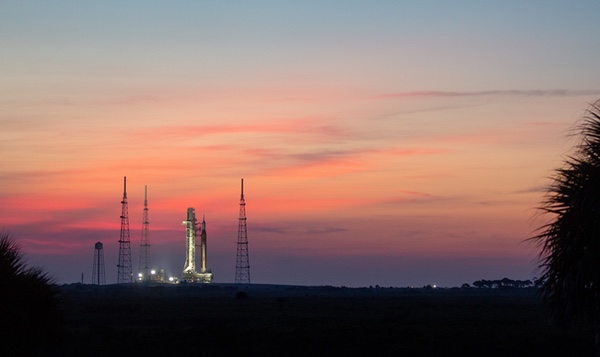 SLS arrive at the pad last week for the Artemis 1 launch. (credit: NASA/Joel Kowsky) |
Other mission objectives
Artemis 1 has a fourth mission objective beyond reentry, testing of SLS and Orion systems, and recovering Orion after splashdown. The “additional flight test objectives” is a catch-all for a range of other tests on Orion during the mission, testing various spacecraft technologies from radiators to cameras mounted on the tips of its solar arrays.
There are also payloads inside Orion that will be tested during the flight. Mannequins will measure the radiation environment that astronauts will be exposed to during a flight as well as the effectiveness of a vest to shield astronauts from that radiation. Lockheed Martin, working with Cisco WebEx and Amazon, will test the use of Amazon’s Alexa voice-based computing system inside Orion.
Rob Chambers, director of commercial civil space strategy at Lockheed Martin, said in a briefing last week he expected to get a puzzled response from Amazon when contacting them about participating in the project, called Callisto. “Instead, they explained that one of the progenitors for Alexa, one of the thoughts that they had, if you will, was the voice computer from the Starship Enterprise,” he recalled. “In some ways, they said, they had been kind of waiting for this moment.”
Artemis 1 will, in addition to Orion and its payloads inside, fly ten cubesat secondary payloads. The ten 6U cubesats, from NASA, international partners, and other organizations, will carry out a variety of missions, from orbiting and even landing on the Moon to testing deep-space communications technologies and using a solar sail to fly by an asteroid.
That is, if the cubesats work. NASA required the cubesats to be delivered nearly a year ago so they could be installed on a payload adapter, on top of which Orion was attached. Once Orion was installed, those cubesats were inaccessible. While five of the cubesats had the ability to recharge their batteries, the other five, for various reasons, did not, raising concerns that by the time they launch, their batteries will be dead. Those cubesats have solar panels, but a lack of battery power could disrupt critical early operations after deployment from the SLS.
“We’re trying to work through the preparations and get the SLS ready to fly. That’s the best thing we can do at this point,” said Jacob Bleacher, NASA chief exploration scientist, when asked about the battery issues with the cubesats at a briefing last week. “If we can get the SLS off at the end of this month or early September, we hope that they’ll all have an opportunity to be able to fly.”
Craig Hardgrove, principal investigator for one of the cubesats, LunaH-Map, said the inability to charge that cubesat came out of prelaunch reviews. “The SLS program didn’t feel comfortable with us charging,” he said, but didn’t elaborate. Even if battery levels drop below the minimum needed to start its flight computer after deployment, he said two exposed solar arrays should generate enough power to charge the batteries “in not too much time.”
Another cubesat identified by NASA as not being able to charge is Team Miles, which won its spot on the mission through the Centennial Challenges prize program. Wesley Faler, leader of Team Miles, said that was a deliberate choice. “We had an opportunity to charge but we opted out of it,” he said, based on the low rate of battery discharge. “We figured, why rock the boat and introduce the variable of recharging?”
Planning for the future
As NASA moves into the final stages of preparations for Artemis 1, it is also moving ahead on Artemis 2, the first crewed flight. That mission is likely to launch no earlier than late 2024, depending in part on the outcome of Artemis 1.
| “As long as you are healthy,” Wiseman said, “we’re going to load you on a rocket and shoot you off the planet.” |
NASA has yet to announce who will fly on the mission, although one of the four seats will go to a Canadian astronaut as part of an agreement between NASA and the Canadian Space Agency whereby Canada provides a robotic arm for the lunar Gateway. Canada, in return, gets a seat on Artemis 2 and a later Gateway mission.
“The question everyone will ask is when are we assigning a crew to Artemis 2? We hope that will be later this year,” said Reid Wiseman, NASA chief astronaut, at a briefing earlier this month.
In late 2020, NASA announced the selection of 18 astronauts as part of an “Artemis Team” that would be considered for future Artemis flight assignments. That announcement came at a National Space Council meeting where outgoing Vice President Mike Pence announced the 18 astronauts, calling them “heroes of the future.”
However, Wiseman said that the entire astronaut corps of 42 active astronauts (with ten more in training) would be considered for Artemis 2 and later missions, not just the Artemis Team astronauts, a point he emphasized several times at that briefing.
“The way I look at it, any one of our 42 active astronauts is eligible for an Artemis mission,” he said, a point he emphasized several times during the briefing. “We want to assemble the right team for this mission.”
NASA, he also said, was changing radiation standards based on recommendations from a National Academies study last year, doing away with separate standards based on age and gender to a single one. Doing so, that study argued, would provide more flight opportunities for women who previously had a lower radiation standard.
“As long as you are healthy,” he said, “we’re going to load you on a rocket and shoot you off the planet.” But first, Artemis 1 has to demonstrate that the rocket, and the spacecraft, are ready for astronauts.
Jeff Foust (jeff@thespacereview.com) is the editor and publisher of The Space Review, and a senior staff writer with SpaceNews. He also operates the Spacetoday.net web site. Views and opinions expressed in this article are those of the author alone.







